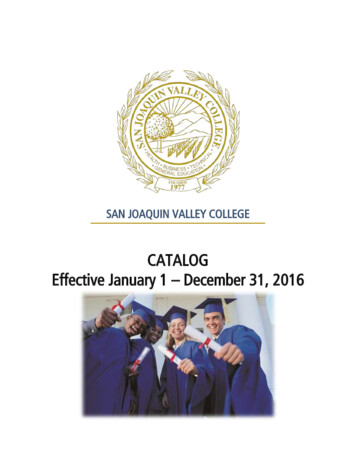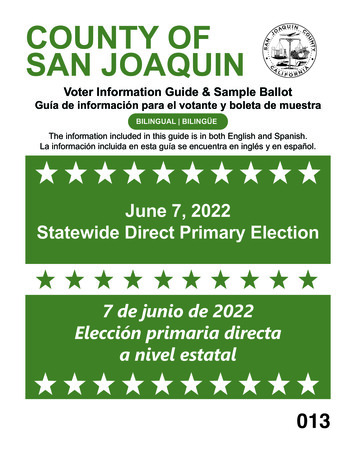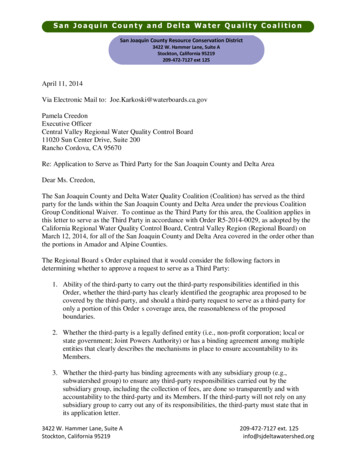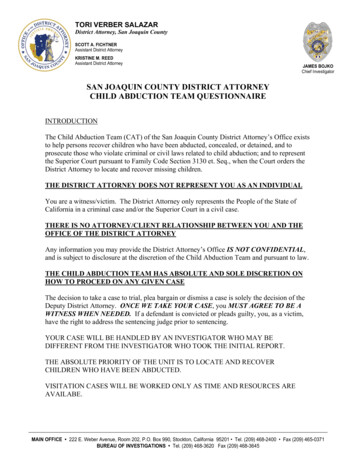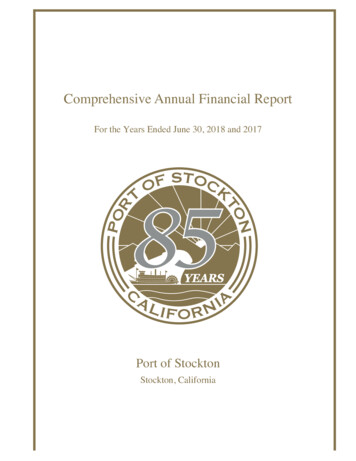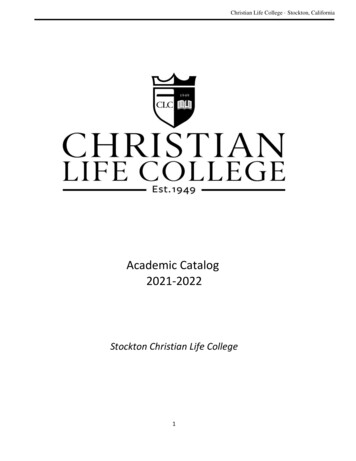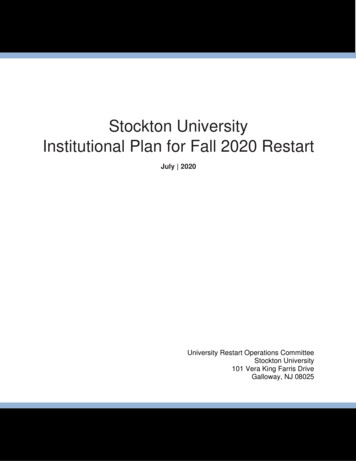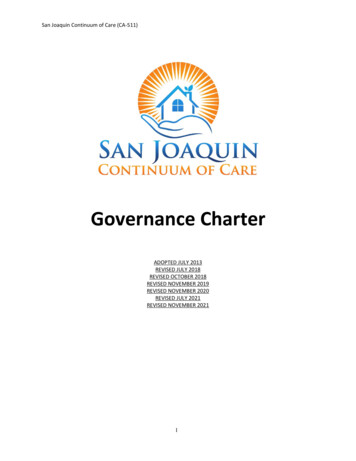
Transcription
San Joaquin Continuum of Care (CA-511)Governance CharterADOPTED JULY 2013REVISED JULY 2018REVISED OCTOBER 2018REVISED NOVEMBER 2019REVISED NOVEMBER 2020REVISED JULY 2021REVISED NOVEMBER 20211
San Joaquin Continuum of Care (CA-511)Preamble:A Continuum of Care (CoC) has served San Joaquin County since 1996, enabling the greaterSan Joaquin County community to respond to homelessness by implementing permanenthousing projects. In 2015, at the request of several community-based homeless servicesproviders, Supervisor Kathy Miller convened a working group of providers, first respondersand interested parties from throughout San Joaquin County to explore opportunities foraddressing the issue of homelessness. In January of 2016, the San Joaquin County Board ofSupervisors took action to expand the membership and officially designate the group theSan Joaquin County Homelessness Task Force. The Homelessness Task Force (HTF) metmonthly to exchange information, share best practices, and foster collaboration to improvehomelessness outcomes on a county-wide basis.In 2016 and 2017, the HTF presented the San Joaquin County Board of Supervisors withrecommendations that resulted in the formal adoption of over-arching policies regardingdata collection, adoption of a Housing First model, creation of uniform discharge policies, a“No Wrong Door” approach to service delivery, and development of new collaborations andpartnerships to secure funding for innovative initiatives. In 2018, the local charter wasrevised to incorporate and build upon the success of the HTF and enhance the San JoaquinContinuum of Care (SJCoC) as a more robust, active, and collaborative entity. In 2019, theSan Joaquin County Board of Supervisors and the Stockton City Council together adoptedthe SJCoC as the backbone agency to provide guidance and recommendations regardingpolicies and actions in response to homelessness. In 2020, San Joaquin County and thecities of Lodi, Stockton, and Tracy adopted the recommendations of the SJCoC’s San JoaquinCommunity Response to Homelessness strategic plan.I.MissionThe SJCoC provides leadership and effective stewardship of resources, as well asfacilitates community planning, design and implementation of programs critical toending homelessness in San Joaquin County. Our core values are collaboration,communication and transparency. We are committed to evidence-based programmingand data-driven initiatives.II. CompositionThe SJCoC is a non-governmental, non-incorporated association that meets therequirements of 24 CFR 578 as a collaborative and coordinating system that includesgovernment, non-profit homeless housing and service providers, and other communityinterests that increases public awareness and promotes programs that addresses theneeds of the County’s homeless population. Groups and organizations that areencouraged to participate in the Continuum include, but are not limited to:A. Organizations and agencies providing behavioral health and substance abuseservicesB. County health departments, community health centers, and hospitalsC. Organizations and agencies providing food, shelter, housing, or other servicestargeted to the homeless2
San Joaquin Continuum of Care (CA-511)D. Local law enforcement agencies, including district attorney, public defender, courts,jails, probation and paroleE. Regional workforce boardsF. County and municipal governmentsG. Local public housing authoritiesH. Housing developersI. Business communityJ. Philanthropic communityK. Local school districtsL. Federal, state and local organizations and agencies serving specific subgroups of thehomeless population, including, but not limited to, those serving veterans, victims ofdomestic violence, persons with HIV/AIDS, LGBT and runaway youthM. Homeless and formerly homeless personsN. Community organizations, including those that are faith-based, that have an interestin addressing issues associated with ending homelessnessO. Organizations that address inequity and serve marginalized populationsP. Individuals from under-represented groups, including racial minorities, members ofthe LGBTQ community, those with disabilities, and othersQ. San Joaquin 211III. ResponsibilitiesEssential responsibilities of the SJCoC include, but are not limited to:A. Operating the SJCoC.B. Designating a Homeless Management Information System (HMIS) and an HMIS LeadAgency.a. Currently, the SJCoC is using HMIS software provided by Bitfocus known asClarity and designates Central Valley Low Income Housing Corporation as theHMIS Lead Agency. The SJCoC Board will execute a Memorandum ofUnderstanding with the HMIS Lead Agency specifying the duties andresponsibilities of the HMIS Lead Agency. The Board will review, approve,and execute an MOU with the HMIS Lead Agency on an annual basis. (Thislanguage shall be updated annually to reflect any changes in HMIS softwareor in the identity of the HMIS Lead Agency.)C. Developing a local homeless strategic plan for the SJCoC’s geographic area thatincludes data from a point-in-time count, an annual Housing Inventory Count, theLongitudinal Systems Analysis, and other required reports.D. Facilitating the delivery of multiagency services for the homeless to eliminateduplication of services and to maximize the use of limited existing resources for thehomeless.E. Support the development of new approaches to provide housing opportunities forthe homeless.F. Providing information required to complete jurisdictional Consolidated Plans withinthe Continuum’s geographic area of San Joaquin County, including inventory of gapsin homeless services.3
San Joaquin Continuum of Care (CA-511)G. Consulting with State and local government Emergency Solutions Grant recipientswithin the Continuum’s geographic area on the plan for allocating ESG funds andreporting on and evaluating the performance of ESG program recipients and subrecipients.H. Establishing priorities for funding homeless projects within the Continuum’sgeographic area.I. Consulting with ESG and CoC Program recipients and sub-recipients to establishperformance targets appropriate for population and program type, monitorrecipient and sub-recipient performance, evaluate project outcomes, and taketimely action against poor performers, as necessary.J. In consultation with recipients of Emergency Solutions Grants program funds withinthe geographic area, establishing and operating a coordinated entry system thatincorporates core coordinated entry elements, including an initial, comprehensiveassessment of the needs of individuals and families for housing and services.K. In consultation with recipients of Emergency Solutions Grants program funds withinthe geographic area, establishing and consistently following written standards forproviding CoC assistance.IV. Governance and MembershipThe SJCoC shall be governed by a Membership Body and a coordinating Board ofDirectors.A. CompositionThe Membership Body consists of all interested individuals and organizations and isopen to the full array of community stakeholders enumerated in Section II of thisdocument. Membership in the SJCoC will be available through an open registrationprocess by contacting the Collaborative Applicant (See Section VII) and expressing adesire to participate in the SJCoC. The Board shall, at least annually, issue a publicinvitation for new members. Stakeholders shall be informed on a regular basis of theSJCoC’s purpose, responsibilities and calendar of events, so as to encourage broad andconsistent participation.B. The Membership Body is responsible for:1. Coordinating services among public and private providers;2. Approval of Governance Charter and electing members of the Board; and3. Authorizing the submission of the annual CoC Program application.V.Board of DirectorsA. CompositionThe Board shall be composed of no less than thirteen (13) and not more than 21active members who represent the Collaborative Applicant, the HMIS Lead Agency,and diverse, relevant stakeholders of the Membership Body. The SJCoC shall strive4
San Joaquin Continuum of Care (CA-511)to ensure broad geographic coverage on the Board and on committees, torepresent the subpopulations of people experiencing homelessness in the SJCoC,and to represent individuals of diverse backgrounds, experiences, and identities. Atleast one member of the Board shall be a homeless or formerly homeless personand at least one member shall be an ESG recipient or sub-recipient.B. Election and TermsThe Nominating Committee presents a slate of members for election at the AnnualMeeting to terms beginning January 1 and ending December 31. The NominatingCommittee is a standing committee of the SJCoC; individuals seeking a competitiveseat on the Board are not eligible to participate in that committee. The MembershipBody elects each Board member to a two-year term.C. Attendance and QuorumBoard members may not miss more than two consecutive, unexcused Boardmeetings. The presence of a simple majority of Board Directors will be a quorumand sufficient to conduct business at Board meetings.D. Vacancies and RemovalA vacancy of any member position may be filled by a majority vote of the Board forthe unexpired portion of the term. Board members may be removed from the Boardfor violations of the conflict of interest policy, attendance policy or for otherviolations of the policies and procedures of the SJCoC. Removal of a board memberrequires a 2/3 vote of Board members or 2/3 vote of the Active Members of theSJCoC.E. Duties and ResponsibilitiesThe Board shall have the power to act on behalf of and in the best interest of theSJCoC. These duties include the following:1. Establishment of Standing and/or Ad Hoc Committees, such as CoC ProgramApplication Committee or Point in Time Committee;2. Determination of scope, purview, and duties of Committees;3. Provide guidance to committees regarding Committee Chairs; Committeesmay appoint their own chairs;4. Service on SJCoC committees;5. Review and approval of CoC Program applications, and direct theCollaborative Applicant to submit the application;6. Oversight of and coordination with the HMIS Lead Agency;7. Execution of the essential responsibilities listed in Section III;8. Approval of all SJCoC policies, including but not limited to those forcoordinated entry system, written standards and HMIS, systemperformance and evaluation, annual CoC Program Competition rankand review tool, reallocation tool, and policy recommendations toelected officials and non-CoC bodies;9. Evaluation of Collaborative Applicant and HMIS Lead; and5
San Joaquin Continuum of Care (CA-511)10. Other such responsibilities approved by the Membership Body.F. Board OfficersThe Board of Directors will elect Board Officers for vacant seats at their first regularmeeting of the calendar year. The Chair and Vice Chair may not represent the sameorganization. The Board shall strive to elect Officers who represent differentsectors/constituencies.a. ChairThe chair shall prepare the agenda for and preside at the meetings of theMembership and the Board of Directors. The chair shall provide directionand leadership, along with the Board, to ensure that all functions of theSJCoC are carried out.b. Vice-ChairThe Vice Chair shall represent the Chair in his/her absence andsupport the Chair.c. SecretaryThe Secretary shall be responsible for record-keeping at a leveldetermined by the Board of Directors.d. Term of OfficeThe Board Officer term of service shall be one year.e. Board officers will provide support to the Board Chair in establishingmeeting agendas and other issues as necessary.VI.Initial Standing CommitteesA.Coordinated Entry System CommitteeThis committee is responsible for developing, monitoring the progress andimpact of, and periodically recommending any necessary revisions to animplementation plan for a coordinated entry and assessment system for allhomeless and prevention resources. This committee will createrecommendations for written standards for eligibility, assessment, andprioritization of resources for all CoC and ESG program types.B.Data and HMIS CommitteeThis committee develops policies and procedures and provides oversight to theHMIS Lead Agency on HMIS issues including project participation, participantprivacy, data security, data quality, data sharing and HMIS governance. ThisCommittee provides oversight to the annual Point-in-Time Count of shelteredand unsheltered homeless, in accordance with any HUD requirements. Itassists the HMIS Lead Agency with ensuring HMIS participation across theSJCoC. The HMIS lead executes Participation Agreements with eachcontributing HMIS organization, ensures that each HMIS user has signed anHMIS User Agreement, manages the system on a day-to-day basis, andprovides technical support and training to users. Additional expectations aredocumented as part of the HMIS policies and procedures. All CoC funded6
San Joaquin Continuum of Care (CA-511)projects and all ESG sub-recipients are required to enter data in HMISaccording to the standards set by the HMIS Lead Agency and the Board. Allservice providers in the Continuum will be invited to participate in datacollection in the HMIS. This committee also hears grievances related tosanctions by the HMIS Lead agency. This committee will lead the annualprocess of reviewing the performance of the HMIS Lead Agency and of theHMIS vendor.C.Education and Membership CommitteeThis committee will be responsible for developing an outreach plan to educatethe community on homeless issues, including persons/organizations that are notcurrently members. The Committee will support the development of communityresource directories of services available to the homeless, such as 211 SanJoaquin, for use by agencies, volunteers, information and referral systems, andhomeless persons. The Committee will establish and periodically reviewmembership participation in the SJCoC, along with developing a strategy forincreasing the support and participation from municipalities and local businessesin the SJCoC’s programs and activities. The committee will also develop (1) amembership information kit that may include the governance charter,membership list, and membership benefits and (2) CoC Grant Application/Management training course.D.Resource Development CommitteeThis committee will identify resources and coordinate development ofeducation, advocacy, and training strategies targeted to increasing resourcesfor the SJCoC to address homelessness in San Joaquin County.E.System Performance and Evaluation CommitteeThis committee is responsible for several planning activities including: Establishing system performance metrics and standards; Evaluating system performance; Establishing metrics and standards for measuring the performance of ESGand CoC-funded projects; Evaluating performance of those CoC and Emergency Solution Grant fundedprojects; Providing recommendations of remedial actions and quality improvementplans for poor-performing projects to the Board of Directors and themembership; Establishing priorities, metrics and standards for other funding sourcesdirectly allocated to the SJCoC; or when feasible, other funding sources notdirectly allocated to the SJCoC but which may have a substantial impact onservice delivery to homeless households; Encouraging development of new programs and services to fill critical servicegaps, if necessary, through reallocation of existing resources for thehomeless; and7
San Joaquin Continuum of Care (CA-511) F.Reviewing and updating on an annual basis the reallocation, local rank andreview tools, rubrics and scoring priorities for the Annual CoC ProgramCompetition.Strategic Planning CommitteeThis committee is responsible for: Developing goals, plans and strategies to carry out the mission of the SJCoC. Develop and annually review a regional strategic plan to addresshomelessness in the SJCoC. Document progress toward goals, strategies, and measurable outcomesoutlined in the strategic plan Gathering information or conducting needs assessments related to endinghomelessness, including the annual gaps analysis required by HUD. Conducting an inventory of all local resources for the homeless, including butnot limited to, food assistance, clothing, emergency shelter, low-costhousing, emergency medical care, counseling, education, job training, childcare and employment. Monitoring and evaluating federal, state and local homeless initiatives toassess their impact, to determine the adequacy of services through suchinitiatives, and to identify additional unmet needs of the homeless.Strategic Planning Sub-committees may include Housing, Prevention, Law &Justice, and other sub-committees deemed necessary by this committee.VII.Other CommitteesOther committees established by the Board shall have their scope and purviewdetermined by the Board. Any committees in existence and active for more than one(1) calendar year shall have a written scope added to the SJCoC Governance Charter.This scope and purview may be changed by majority vote of the Board with input fromthe Committee itself. Committees may also be eliminated by majority vote of theBoard. Standing Committees established after the initial adoption of the GovernanceCharter are as follows:Shelter CommitteeThis Committee is responsible for enhancing the community’s and the SJCoC’sunderstanding of the operation, successes, and challenges of emergencyshelter for the homeless within the SJCoC. This Committee may recommendpolicies and actions to the Board for adoption regarding emergency shelter,including but not limited to seasonal or weather-related capacity, priorities forshelter expansion, etc. This Committee may help identify shelter expansionprojects that meet SJCoC-published guidance such as the “Shelter ThatSucceeds” report and help those projects identify locations, funds, and otherresources to be actionable. This Committee may also provide guidance to localservice providers so that their operations meet SJCoC standards and guidance,8
San Joaquin Continuum of Care (CA-511)as well as standards established by funding sources such as EmergencySolutions Grants, Homeless Housing Assistance and Prevention, etc.Youth Action BoardThis committee is made up of youth and young people 24 years of age oryounger, who have been impacted by homelessness. This committee isresponsible for providing youth perspective and recommendations on policyand other efforts, particularly those that that may directly impact youth andyoung people. This committee promotes activism in community andgovernmental affairs and acts as a resource for the Board and StandingCommittees.Nominating CommitteeThis committee is responsible for managing the process to fill Director andOfficer seats on the Board of Directors. This committee may periodicallydevelop and recommend policies, procedures, and process improvementsrelated to ensuring broad representation on the Board by geography, withinsubpopulations of people experiencing homelessness, and by individuals ofdiverse backgrounds, experiences, and identities.VIII.Collaborative ApplicantThe Board shall designate a Collaborative Applicant for all CoC Programapplications. A Memorandum of Understanding between the SJCoC and theCollaborative Applicant will delineate duties and responsibilities, including thecollection, combination and submission of all required annual CoC ProgramCompetition project and overall application information within the SJCoC’sgeographic area and maintenance of required records. Under this MOU, theCollaborative Applicant may also act in a similar capacity for other funds that maybe awarded to the SJCoC, for example grants allocated directly to Continuums ofCare by the State of California. The Board will review and evaluate theperformance of the Collaborative Applicant on an as-needed basis, and the Boardwill approve and execute the Collaborative Applicant MOU on an annual basis.Currently, the SJCoC has designated San Joaquin County as the CollaborativeApplicant.IX.MeetingsA. General MembershipMeetings of the Membership shall be held at least three times per year, includingan Annual Meeting. An agenda of the meeting will be published at least 72 hoursprior to the meeting through the Continuum membership, email listingmaintained by the Collaborative Applicant, and through postings in public places.All meetings are open to the public. The Board Chair shall conduct the meetings.Meetings will follow the published agenda and shall be conducted by Robert’sRules of Order (as revised). Minutes shall be recorded of every meeting, by a9
San Joaquin Continuum of Care (CA-511)party to be determined by the Board of Directors.B. Annual MeetingThe SJCoC will hold an Annual Meeting each year. Election of the Board ofDirectors will take place at this meeting. Other business may include approval ofthe annual CoC Program application and the approval of changes to theGovernance Charter.C. Board of DirectorsThe Board of Directors shall meet at least six times per year. An agenda of themeeting will be published at least 72 hours prior to the meeting through theContinuum membership, email listing maintained by the Collaborative Applicantand through postings in public places. All meetings are open to the public. Boardmeetings may be conducted via electronic platforms, on the condition that theseplatforms are made available to the public for virtual attendance andparticipation. Electronic meetings are subject to the same notice requirements ofin-person meetings.D. CommitteesCommittee meetings shall be held as needed, but not less than twice per year.Meeting action shall be reported at regular meetings of the Board of Directorsand General Membership.E. Special MeetingsSpecial Meetings of the General Membership or Board of Directors may be calledby the Board Chair or by written request of one-third of the Board or by one-thirdof Active Members Special meetings that will require a vote or the handling ofofficial business of the SJCoC require at least 48 hours prior notice via email by theCollaborative Applicant. Special meetings may consider only those items sospecified in the notice. Special meetings may be conducted via electronicplatforms, on the condition that these platforms are made available to the publicfor virtual attendance and participation. Electronic meetings are subject to thesame notice requirements of in-person meetings.X.Voting/ QuorumA. Only Active Members are eligible to vote on matters before the SJCoC.Active members are divided into two categories: Individuals andOrganizations.a. Individuals are defined as individuals who are not volunteers or employees ofany entity that might otherwise be a member, with the exception of personsexperiencing homelessness or who previously experienced homelessness.b. Organizations are defined as, including but not limited to, School districts, but not individual schools 501(c)3 social service organizations10
San Joaquin Continuum of Care (CA-511) individual religious congregations/organizations or faith-based organizationsindividual private businesses or business organizationsphilanthropic foundationspublic or private health care organizationspublic or private mental health organizationspublic or private substance disorder organizationslaw enforcement agencies operating within the boundaries of San JoaquinCountyindividual cities (with an elected city council) within San Joaquin CountyFederal, state and local governmentB. Active Members are defined as members who have attended at least 50% ofMembership or Committee meetings in the prior twelve-month period.C. Questions or disputes about Active Membership will be resolved by the Board ofDirectors.D. Voting will occur in person unless otherwise determined.E. The presence of ten (10) or more of the Active members will represent aquorum and be sufficient to conduct business at Membership meetings.F. Action at Membership, Board and Committee meetings will be taken by anaffirmative vote of simple majority of active members present.XI.Grant/Contract Selection ProcessThe Board shall designate, through a Memorandum of Understanding, the applicantand administrative agent of HUD CoC grants. The grant/contract selection process mustbe organized to serve the interests of the community in an impartial and neutralmanner. All grants and contracts awarded by the SJCoC shall be as a result of a publicrequest for proposal (RFP) process. The RFP shall be advertised through the SJCoCmeetings, email listings maintained by the Collaborative Applicant, and throughpostings on the SJCoC website maintained by Collaborative Applicant. All proposalsshall be collected by the Collaborative Applicant and reviewed for all requiredelements. All qualifying proposals shall be submitted to the Application Committee forevaluation and scoring. Evaluation of applications shall be based upon prioritiesestablished by the SJCoC. The Application Committee shall present the result of theirreview to the Board for approval. Following Board approval, the Collaborative Applicantshall submit the applications as approved. Appeals of the Board’s decision shall besubmitted in writing to the Board within 48 hours of the decision for consideration.Appeals that impact the timely submittal of a grant application to HUD will be heardafter the submittal date. A successful appeal in this case may result in an amendmentto the application. The HUD CoC Program Notice of Funding Availability (NOFA) will becontrolling in all aspects of the Grant/Contract selection process. In cases where theSJCoC has responsibility for designing and implementing a public process to apply forgrant funds not associated with the CoC Program Competition, such as a State or Localprogram in which a direct allocation of funds has been granted to the SJCoC, theprovisions of this section shall apply where possible.11
San Joaquin Continuum of Care (CA-511)XII. Conflict of InterestA. Board MemberIn accordance with 24 CFR 578.95(b), no board member may participate in orinfluence discussions or resulting decisions concerning the award of a grant orother financial benefits to the organization that the member represents. Anymember of the Continuum with a conflict shall recuse themselves from anydiscussion or vote on a matter in which they have a conflict.B. Organizational conflict.An organizational conflict of interest arises when, because of activities orrelationships with other persons or organizations, the recipient or subrecipient isunable or potentially unable to render impartial assistance in the provision of anytype or amount of assistance under this part, or when a covered person‘s, as inparagraph D (cited below), objectivity in performing work with respect to anyactivity assisted under this part is or might be otherwise impaired. Such anorganizational conflict would arise when a board member of an applicantparticipates in decision of the applicant concerning the award of a grant, orprovision of other financial benefits, to the organization that such memberrepresents. It would also arise when an employee of a recipient or subrecipientparticipates in making rent reasonableness determinations under 24 CFR578.49(b)(2) and 578.51(g) and housing quality inspections of property under 24CFR 578.75(b) that the recipient, subrecipient, or related entity owns.C. The Chair of the Board will be responsible for monitoring the disclosure ofmembers’ conflicts of interest. In the event that a matter, which raises a potentialconflict of interest, comes before the SJCoC, the Board, or its Committees orworkgroups for consideration, recommendation, and decision, the Member shalldisclose the conflict of interest as soon as he or she becomes aware of it. Minutesof meetings involving possible conflicts of interest shall record such disclosure,abstention, and rationale for approval.D. No covered person, meaning a person who is an employee, agent, consultant,officer, or elected or appointed official of the recipient or its subrecipients andwho exercises or has exercised any functions or responsibilities with respect toactivities assisted under this part, or who is in a position to participate in adecision-making process or gain inside information with regard to activitiesassisted under this part, may obtain a financial interest or benefit from an assistedactivity, have a financial interest in any contract, subcontract, or agreement withrespect to an assisted activity, or have a financial interest in the proceeds derivedfrom an assisted activity, either for him or herself or for those with whom he orshe has immediate family or business ties, during his or her tenure or during theone-year period following his or her tenure.E. Members found violating the conflict of interest policy or federal regulations will bereferred to the Board of Directors. The Board of Directors shall investigate all12
San Joaquin Continuum of Care (CA-511)allegations of failure to comply with this conflict of interest policy. If a SJCoCmember is found to have violated the letter or intention of this conflict of interestpolicy, the Board of Directors will be responsible for recommending an appropriateresponse to this breach of policy. The Board of Directors may recommend any actionincluding but not limited to a statement of reprimand recorded in the Board minutes orremoval from the board or other action.XIII. Board Code of ConductThe Members of the Board are entrusted with specific responsibilities related to use ofpublic funds invested in addressing a serious community concern, homelessness.Members are expected to observe the highest standards of ethical conduct in theexecution of these responsibilities. In the performance of their duties, Board Membersare expected to carry out the mission of the SJCoC to the best of their ability, and tomaintain the highest standards of integrity for actions with other Members of the Board,with SJCoC members, service recipien
San Joaquin County community to respond to homelessness by implementing permanent housing projects. In 2015, at the request of several community-based homeless services providers, Supervisor Kathy Miller convened a working group of providers, first responders and interested parties from throughout San Joaquin County to explore opportunities for .
